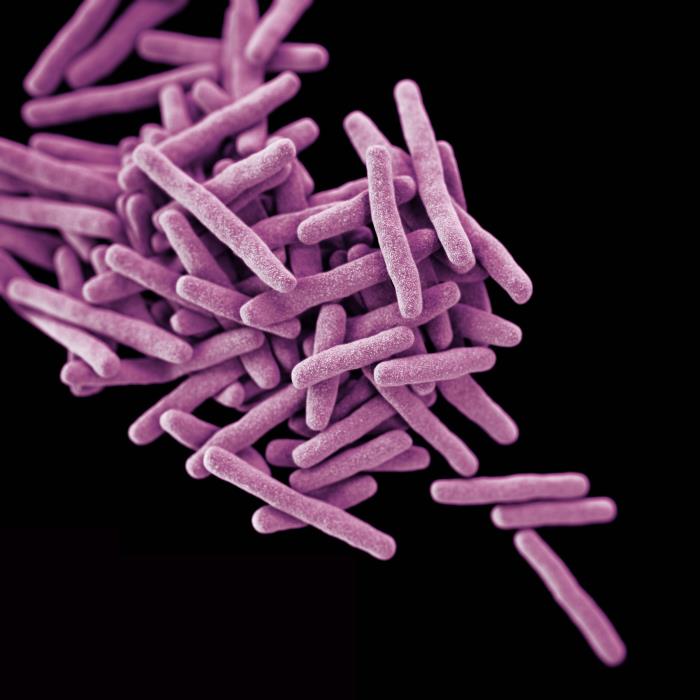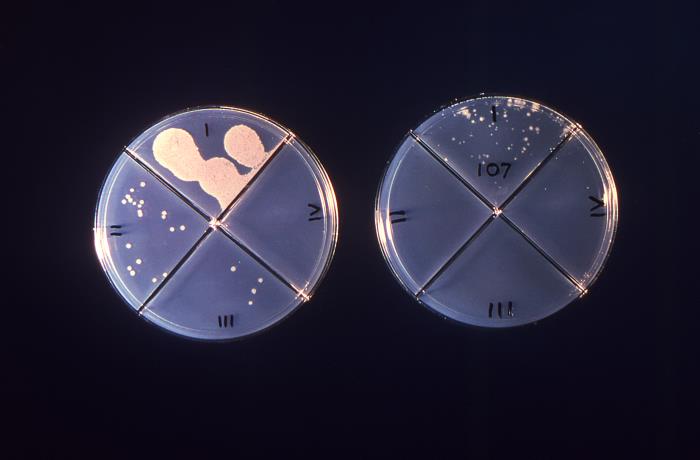Multi-drug-resistant tuberculosis causes
|
Multi-drug-resistant tuberculosis Microchapters |
|
Differentiating Multi-drug-resistant tuberculosis from other Diseases |
|---|
|
Diagnosis |
|
Treatment |
|
Case Studies |
|
Multi-drug-resistant tuberculosis causes On the Web |
|
American Roentgen Ray Society Images of Multi-drug-resistant tuberculosis causes |
|
Directions to Hospitals Treating Multi-drug-resistant tuberculosis |
|
Risk calculators and risk factors for Multi-drug-resistant tuberculosis causes |
Editor-In-Chief: C. Michael Gibson, M.S., M.D. [1]; Associate Editor(s)-in-Chief: João André Alves Silva, M.D. [2]
Synonyms and keywords: M. Tuberculosis
Overview
Mycobacterium tuberculosis is the bacterium responsible for tuberculosis. It is an aerobic, non-encapsulated, non-motile, acid-fast bacillus. M. tuberculosis belongs to the Mycobacterium tuberculosis complex, that also includes bacteria, such as M. bovis and M. africanum. The bacterium has a very slow rate of replication, and its genetic variations account for the geographical distribution of different strains, and are involved in drug resistance. M. tuberculosis has tropism for different kinds of human cells, with preference for cells of the lung. It may infect different species, yet human beings are its frequent natural reservoir.
Taxonomy
 |
 |
Cellular organisms; Bacteria; Actinobacteria; Actinobacteria; Actinobacteridae; Actinomycetales; Corynebacterineae; Mycobacteriaceae; Mycobacterium; Mycobacterium tuberculosis complex; M. tuberculosis[3]
Biology
Mycobacterium tuberculosis belongs to the Mycobacterium tuberculosis complex. This complex includes M. tuberculosis, M. bovis, M. africanum, M. canetti, and M. microti.[4]
M. tuberculosis is an obligate aerobe, non-encapsulated, non-motile, acid-fast bacillus. Slender, straight or slightly curved bacillus with rounded ends, occuring singly, in pairs or in small clumps. It does not form spores and its ideal growing environment includes tissues with high levels of oxygen. It cannot be considered gram positive or gram negative due to its high lipid cell wall, which is impermeable to the dyes until combined with an alcohol. On microscopic examination of sputum samples, the bacteria cannot be distinguished from other acid-fast bacteria, such as Nocardia app.[4]
M. tuberculosis has a very slow rate of replication, taking about 15 to 20 hours to divide. This characteristic, added to its ability to remain in the latent state for long periods of time, account for the long treatment duration required.[4]
Genetic variances in the genome of M. tuberculosis lead to important phenotypical changes. There are many different strains of the bacteria, however, 6 of them were noted to be associated with specific geographic areas. This data is important since 3 strains, the Beijing family, strain W and the W-like strains, were noted to be associated with resistance to treatment drugs.[5][6]
Tropism
M. tuberculosis can infect different cells of the human body, however, due to its preference for tissues with high oxygen levels, its cellular tropism is mostly directed towards lung cells.[4]
Natural Reservoir
Human beings are the main natural reservoir for M. tuberculosis, however, the bacteria may infect other species.[4]
References
- ↑ "http://phil.cdc.gov/phil/details.asp". External link in
|title=(help) - ↑ "http://phil.cdc.gov/phil/details.asp". External link in
|title=(help) - ↑ "Mycobacterium tuberculosis".
- ↑ 4.0 4.1 4.2 4.3 4.4 Lawn SD, Zumla AI (2011). "Tuberculosis". Lancet. 378 (9785): 57–72. doi:10.1016/S0140-6736(10)62173-3. PMID 21420161.
- ↑ Smith NH, Hewinson RG, Kremer K, Brosch R, Gordon SV (2009). "Myths and misconceptions: the origin and evolution of Mycobacterium tuberculosis". Nat Rev Microbiol. 7 (7): 537–44. doi:10.1038/nrmicro2165. PMID 19483712.
- ↑ Gagneux S, Small PM (2007). "Global phylogeography of Mycobacterium tuberculosis and implications for tuberculosis product development". Lancet Infect Dis. 7 (5): 328–37. doi:10.1016/S1473-3099(07)70108-1. PMID 17448936.